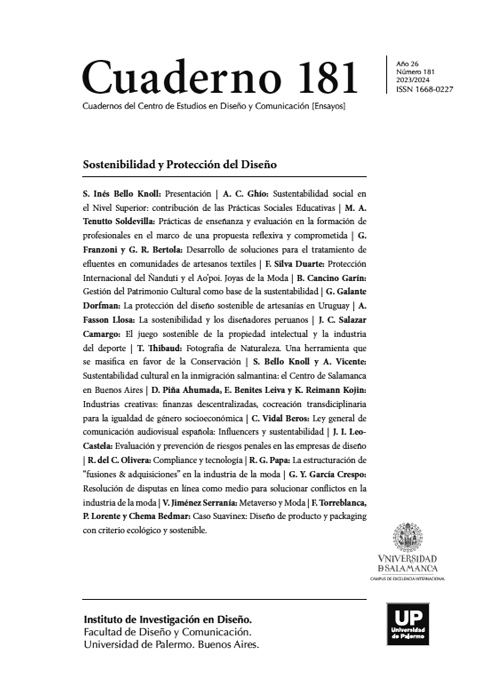Desarrollo de soluciones para el tratamiento de efluentes en comunidades de artesanos textiles
Résumé
La identificación de técnicas efectivas y naturales para el tratamiento de efluentes recalcitrantes de la industria textil artesanal, utilizando como fuente de información la búsqueda de bases de datos de patentes, entre otros recursos, da como resultado una capacitación para artesanos de la región andina en Latinoamérica.
Références
Baughman, G.L., Perkins, W.S., Lasier, P.J., Winger, P.V. (2003). Effect of treatment in a constructed wetland on toxicity of textile wastewater, Review 3 (2003) 28-30.
Bisschops, I., & Spanjers, H. (2003). Literature review on textile wastewater characterisation. Environmental technology, 24(11), 1399-1411.
Bulc, T. G., & Ojstršek, A. (2008). The use of constructed wetland for dye-rich textile wastewater treatment. Journal of hazardous materials, 155 (1-2), 76-82.
Chandanshive, V. V., Kadam, S. K., Khandare, R. V., Kurade, M. B., Jeon, B. H., Jadhav, J. P., & Govindwar, S. P. (2018). In situ phytoremediation of dyes from textile wastewater using garden ornamental plants, effect on soil quality and plant growth. Chemosphere, 210, 968-976.
Davies, L. C., Carias, C. C., Novais, J. M., & Martins-Dias, S. (2005). Phytoremediation of textile effluents containing azo dye by using Phragmites australis in a vertical flow intermittent feeding constructed wetland. Ecological Engineering, 25(5), 594-605.
Delgadillo, O. (2010). Depuración de aguas residuales por medio de humedales artificiales. Nelson Antequera.
Farheen, K. S., Reyes, N. J., & Kim, L. H. (2021). Constructed Wetlands in Treating Domestic and Industrial Wastewater in India: A Review. Journal of Wetlands Research, 23(3), 242-251.
Grimau, V. L. & Crespi Rosell, M. (2015). Gestión de los efluentes en la industria textil. Cuaderno Tecnológico Nº 18. Instituto Nacional de Tecnología Industrial. Delegación de la Comisión Europea en Argentina.
Jayabalan, J. B., Amirthalingam, S., Sekar, S., Santhanam, N. K., & Manoharan, S. (2020). Treatment of textile effluent using sub surface flow constructed wetlands. In AIP Conference Proceedings (Vol. 2240, No. 1, p. 130001). AIP Publishing LLC.
Kadlec, R. H., & Wallace, S. (2008). Treatment wetlands. CRC press.
Masi, F., Rizzo, A., & Regelsberger, M. (2018). The role of constructed wetlands in a new circular economy, resource oriented, and ecosystem services paradigm. Journal of environmental management, 216, 275-284.
Mbuligwe, E. (2005). Comparative treatment of dye-rich wastewater in engineered wetland systems (EWSs) vegetated with different plants, Water Res. 39 (2005) 271-280.
Metcalf, L., Eddy, H. P., & Tchobanoglous, G. (1991). Wastewater engineering: treatment, disposal, and reuse (Vol. 4). New York: McGraw-Hill.
Noonpui, S., & Thiravetyan, P. (2011). Treatment of reactive azo dye from textile wastewater by burhead (Echinodorus cordifolius L.) in constructed wetland: effect of molecular size. Journal of Environmental Science and Health Part A, 46(7), 709-714.
Reed, S. C. (1993). Subsurface flow constructed wetlands for wastewater treatment: a technology assessment (No. 74). US Environmental Protection Agency, Office of Water.
Rodriguez-Dominguez, M. A., Konnerup, D., Brix, H., & Arias, C. A. (2020). Constructed wetlands in Latin America and the Caribbean: a review of experiences during the last decade. Water, 12(6), 1744.
Saeed, T., & Sun, G. (2013). A lab-scale study of constructed wetlands with sugarcane bagasse and sand media for the treatment of textile wastewater. Bioresource technology, 128, 438-447.
Sarayu, K., & Sandhya, S. (2012). Current technologies for biological treatment of textile wastewater–a review. Applied biochemistry and biotechnology, 167(3), 645-661.
Sasse, L. (1998). DEWATS: Decentralised wastewater treatment in developing countries. BORDA, Bremen Overseas Research and Development Association.
Sethulekshmi, S., & Chakraborty, S. (2021). Textile wastewater treatment using horizontal flow constructed wetland and effect of length of flow in operation efficiency. Journal of Environmental Chemical Engineering, 9(6), 106379.
Shehzadi, M., Afzal, M., Khan, M. U., Islam, E., Mobin, A., Anwar, S., & Khan, Q. M. (2014). Enhanced degradation of textile effluent in constructed wetland system using Typha domingensis and textile effluent-degrading endophytic bacteria. Water research, 58, 152-159.
Tee, H. C., Lim, P. E., Seng, C. E., Nawi, M. A. M., & Adnan, R. (2015). Enhancement of azo dye Acid Orange 7 removal in newly developed horizontal subsurface-flow constructed wetland. Journal of environmental management, 147, 349-355.
UN-HABITAT. (2008). Constructed Wetlands Manual. UN-HABITAT Water for Asian Cities Programme Nepal, Kathmandu.
Wallace, S. D., & Knight, R. L. (2006). Small-scale constructed wetland treatment systems: feasibility, design criteria and O & M requirements. IW
Los autores/as que publiquen en esta revista ceden los derechos de autor y de publicación a "Cuadernos del Centro de Estudios de Diseño y Comunicación", Aceptando el registro de su trabajo bajo una licencia de atribución de Creative Commons, que permite a terceros utilizar lo publicado siempre que de el crédito pertinente a los autores y a esta revista.


